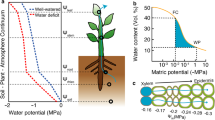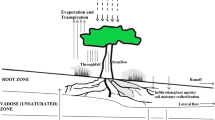Summary
Under controlled conditions, CO2 exchange of Tillandsia recurvata showed all characteristics of CAM. During the phase of nocturnal CO2 fixation stomata of the plant responded sensitively to changes in ambient air humidity. Dry air resulted in an increase, moist air in a decrease of diffusion resistance. The evaporative demand of the air affected the level of stomatal resistance during the entire night period. Due to stomatal closure, the total nocturnal water loss of T. recurvata was less at low than at high humidity. It is concluded that stomata respond directly to humidity and not via bulk tissue water conditions of the leaves. Such control of transpiration may optimize water use efficiency for this almost rootless, extreme epiphyte.
Similar content being viewed by others
References
Biebl, R.: Zum Wasserhaushalt von Tillandsia recurvata L. und Tillandsia usneoides L. auf Puerto Rico. Protoplasma 58, 345–368 (1964)
Conde, L.F., Kramer, P.J.: The effect of vapor pressure deficit on diffusion resistance in Opuntia compressa. Can. J. Bot. 53, 2923–2926 (1975)
Cowan, I.R.: Stomatal Behaviour and Environment. Adv. Bot. Res. 4, 117–228 (1977)
Cowan, I.R., Farquhar, G.D.: Stomatal function in relation to leaf metabolism and environment. In: Integration of activity in the higher plant (D.H. Jennings, ed.). Society for Experimental Biology Symposium 31, 471–505. Cambridge: The University Press 1977
Hall, A.E., Schulze, E.-D., Lange, O.L.: Current perspectives of steady-state stomatal responses to environment. In: Water and plant life (O.L. Lange, L. Kappen, E.-D. Schulze, eds.). Ecological Studies 19, 169–188, Berlin-Heidelberg-New York, Springer-Verlag 1976
Kluge, M., Ting, I.P.: Crassulacean acid metabolism. Ecological Studies 30, Berlin-Heidelberg-New York: Springer-Verlag 1978
Koch, W., Lange, O.L., Schulze, E.-D.: Ecophysiological investigations on wild and cultivated plants in the Negev desert. I. Methods: A mobile laboratory for measuring carbon dioxide and water vapour exchange. Oecologia (Berl.) 8, 296–309 (1971)
Lange, O.L., Koch, W., Schulze, E.D.: CO2-Gaswechsel und Wasserhaushalt von Pflanzen in der Negev-Wüste am Ende der Trockenzeit. Ber. Dtsch. Bot. Ges. 82, 39–61 (1969)
Lange, O.L., Lösch, R., Schulze, E.-D., Kappen, L.: Responses of stomata to changes in humidity. Planta (Berl.) 100, 76–86 (1971)
Lösch, R.: Responses of stomata to environmental factors-experiments with isolated epidermal strips of Polypodium vulgare. I. Temperature and humidity. Oecologia (Berl.) 29, 85–97 (1977)
Lösch, R.: Stomatal response to changes in air humidity. In: Structure, function, and ecology of stomata (D.N. Sen, ed.). in press 1979
Medina, E., Delgado, M., Throughton, J.H., Medina, J.D.: Physiological ecology of CO2 fixation in Bromeliaceae. Flora 166, 137–152 (1977)
Osmond, C.B.: Crassulacean acid metabolism: A curiosity in context. Ann. Rev. Plant Physiol. 29, 379–414 (1978)
Osmond, C.B., Ludlow, M.M., Davis, R.L., Cowan, I.R., Powles, S.B., Winter, K.: Stomatal responses of humidity in Opuntia inermis in relation to control of CO2 and H2O exchange patterns. Oecologia (Berl.), in press (1979)
Raschke, K.: Stomatal action. Ann. Rev. Plant Physiol. 26, 309–340 (1975)
Rauh, E.: Bromelien. Stuttgart: Ulmer 1970
Schulze, E.-D., Lange, O.L., Buschbom, U., Kappen, L., Evenari, M.: Stomatal response to changes in humidity in plants growing in the desert. Planta (Berl.) 108, 159–270 (1972)
Schulze, E.-D., Lange, O.L., Evenari, M., Kappen, L., Buschbom, U.: The role of humidity and leaf temperature in controlling stomatal resistance of Prunus armeniaca L. under desert conditions. I. A simulation of the daily course of stomatal resistance. Oecologia (Berl.) 17, 159–170 (1974)
Sheriff, D.W.: The effect of humidity on water uptake by, and viscous flow resistance of, excised leaves of a number of species: Physiological and anatomical observations. J. Exp. Bot. 28, 1399–1407 (1977)
Stålfelt, M.G.: Die stomatäre Transpiration und die Physiologie der Spaltöffnungen. In: Handbuch der Pflanzenphysiologie III, 351–426, Berlin-Göttingen-Heidelberg: Springer-Verlag 1956
Author information
Authors and Affiliations
Rights and permissions
About this article
Cite this article
Lange, O.L., Medina, E. Stomata of the CAM plant Tillandsia recurvata respond directly to humidity. Oecologia 40, 357–363 (1979). https://doi.org/10.1007/BF00345331
Received:
Issue Date:
DOI: https://doi.org/10.1007/BF00345331




